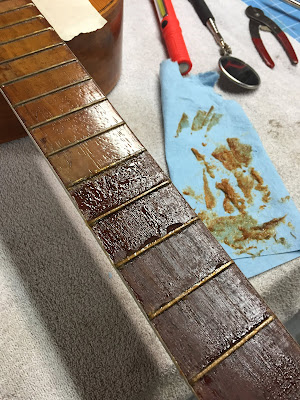 |
| Look at that heavily lacquered fingerboard |
First Update
 |
| Crack repair |
Fingerboard De-lacquering

The fingerboard was coated (over the frets and all) with shellac and it had browned and turned almost butterscotch colored over time which I thought looked really bad and gross. So I taped off the proper edges and took some aircraft paint stripper and went to town on the board with painting the gel, waiting while it bubbles up, and scraping it off with a putty knife.
Eventually I got it almost entirely off and put some oil in the fretboard since its the first time its seen oxygen since it was built.
 |
| Beautiful mystery wood and large brass frets |
 |
| One piece of kerfling had been broken off from the damage to the top, I have the piece but need to reglue it |
 |
| Aforementioned damage |
 |
| The guitar before I took the fretboard off |
I am not willing to do that to this instrument so I took the fretboard off of the guitar, cleaned up some of my damage, and am currently waiting on a long, thin wedge that will go under the fingerboard and lift it up to a better angle for playing.
I discovered that this guitar is finished using a technique called French Polishing which involves wiping shellac on in some manner which I am not familiar with. The end result appears to be a more soft finish that doesn't crack and splinter as easily as a regular lacquer finish. That I think will be beneficial in masking my repairs
The Ramp
This is my drawing that I sketched up to indicate how I planned on building the wedge that would push the fingerboard up to the correct angle in order to have good action through the strings. I've contacted a couple businesses now and am currently waiting for the weekend to pass so I can get a response.
The plan is to glue this wedge to the neck, after I straighten it and put a carbon fiber rod in it, and then glue the fingerboard to the wedge and then I should hopefully have a perfectly playable classical. One of my concerns was that the ramp would cause the guitar to be too thick near the body but luckily that area only is around 1/8th of an inch taller than the neck at the nut so it shouldn't be too bad.













No comments: